The elegant Literate Fence, on the Fifth Street side of the library, was designed by Washington state industrial metal artist, Ries Niemi (b.1955). The Deco design, completed in 1993, echoes the design of the original library building. The fence’s subject matter is an homage to the sculptures by Lee Lawrie over the Hope Street entrance. Lawrie’s reliefs highlight statecraft, history, art and science as pillars of a classic education. The Literate Fence also pays homage to the fundamental purpose of a library, to promote reading and transmit knowledge, especially through major cultures.
The Literate Fence is nine feet tall and 100 feet long and its panels, of welded milled steel, each weighs about 1000 pounds. Niemi added several new topics to the conversation, notably Technology, barely a word when the original building was completed in 1926
Also added were Law & Music along with Biology and Language.

Artist Ries Niemi in his Bellingham Installation.(Photo Courtesy Ries Niemi)
Niemi says he worked “with the head foreign language librarian, along with several other librarians…(to select more than) a dozen quotations about books, knowledge and reading, in languages that each were spoken by over a quarter million people in the Los Angeles area.” Both the quotations and their translations were reviewed by native speakers to insure their accuracy. The intricately cut-out texts and images along the fence are best viewed when backlit.
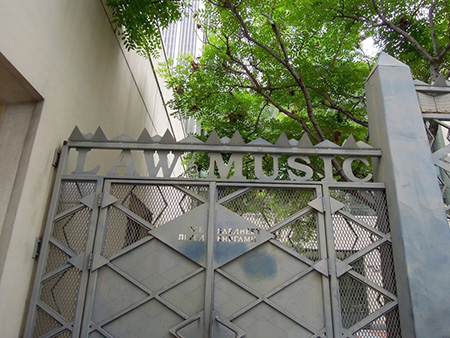
Literate Fence Panels
Moving from left to right, as you face the fence, the panels include:
Law & Music
Upper quote: “Everything pales in front of a book.” Russian by Anton Chekhov (1860-1904), major Russian playwright and master of the modern short story.
Lower quote: “I imagine heaven must be some kind of library.” Spanish. By Jorge Luis Borges (1899-1986), Argentinian Poet, essayist, and short-story writer.
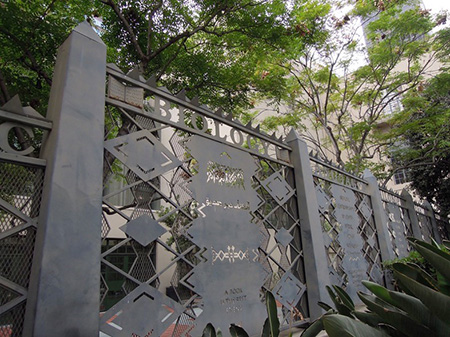
Biology
“A book is the best friend.” Arabic. A traditional proverb.
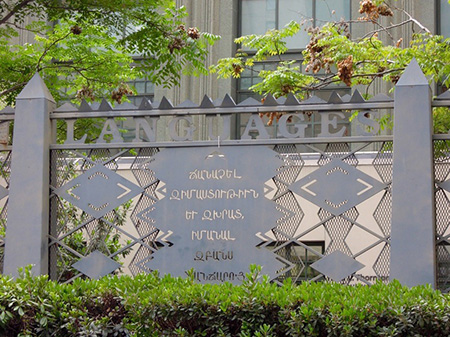
Languages
“Recognize wisdom and counsel; comprehend words of genius.” Armenian. By Mesrop Mashtots (360-440), a Turkish-born monk, theologian and linguist who invented the Armenian script in 405 and helped establish Armenia’s golden age of Christian literature.
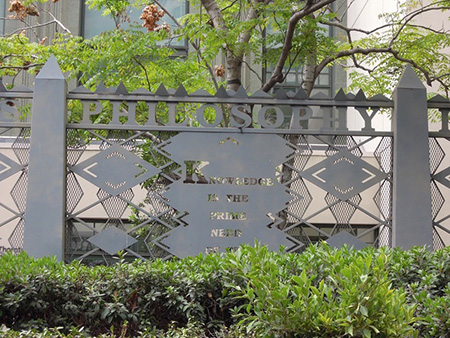
Philosophy
“Knowledge is the prime need of the hour.” English. By Mary McLeod Bethune (1875-1955), Black American educator and civil rights activist; president of the National Association of Colored Women and founder, National Council of Negro Women.
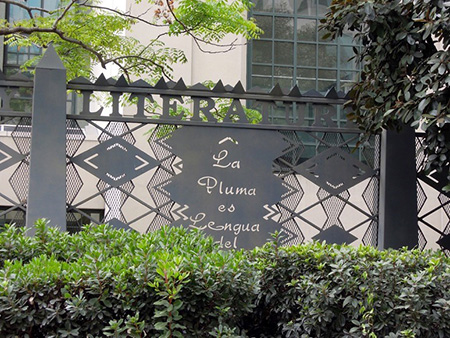
Literature
“The pen is the tongue of the soul.” Spanish. By Miguel de Cervantes (1547-1616), Spain, author of Don Quixote, considered the first modern novel.
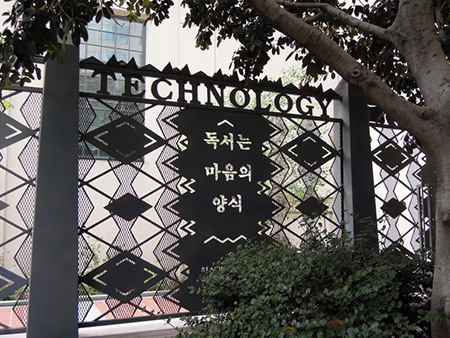
Technology
“Reading is food for the mind.” Korean. A popular saying.
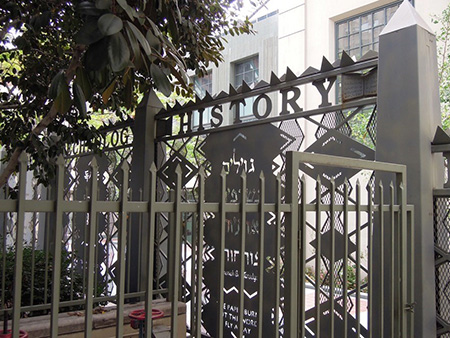
History
“The paper burns, but the words fly away.” Hebrew. By Rabbi Akiva ben Joseph (50-135). Born in Lod, near Jerusalem. First to codify the oral laws of Judaism linking each traditional practice to a basis in biblical text.
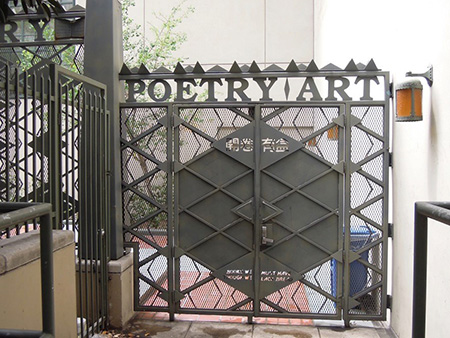
Gate
Poetry & Art
Upper quote: “Open a book and you are profited.” Chinese. Traditional saying which may have originated during the long Sung (Song) dynasty (960-1279).
Lower quote: “Books we must have, although we lack bread.” English. By Alice Williams Brotherton (1848-1930). American poet who wrote Beyond the Veil and the Sailing of King Olaf.
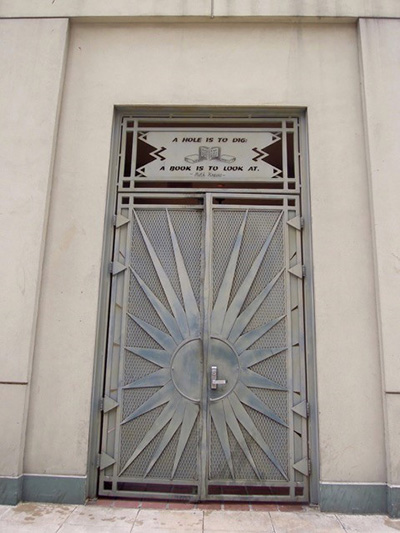
Doors
A large sunburst, a symbol of the library’s theme, “The light of learning,” decorates these doors, to the left (east) of the fence panels.
Window Grilles
Quotes from children’s books are punched through the metal on windows that border one side of the original Children’s Courtyard. They include:
A Hole Is to Dig. English. By Ruth Kraus (1901 –1993). American writer of children's books. This book is subtitled, “a first book of definitions.”
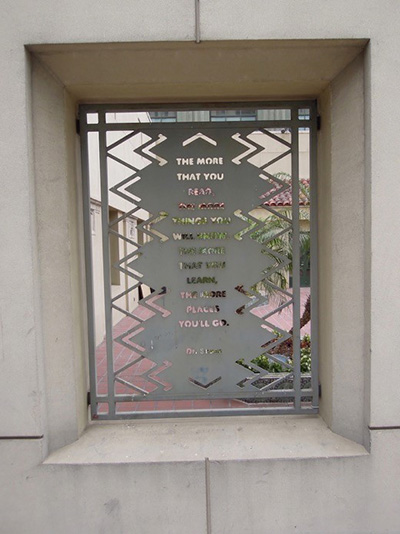
Oh, The Places You Will Go. English. By Dr. Seuss aka Theodor Geisel, (1904-1991). American author of children’s books.
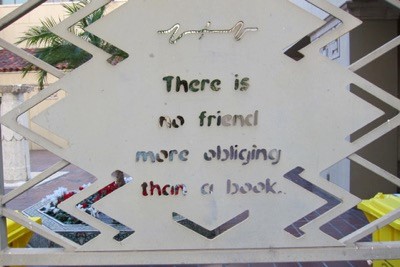
“There is no friend more obliging than a book.” Spanish. By Alfonso Reyes (1889-1959), Mexican-born poet, essayist, short-story writer, literary scholar and critic, educator, lawyer and diplomat.
When first presented with the design of the Literate Fence, library officials were concerned that its smooth top would invite people to climb up over it. Niemi came up with a clever solution: rows of irregularly sized triangles, something both artistically interesting yet likely to give pause to anyone thinking of climbing up and risk tearing their pants (or worse). The triangles are one of several simple graphic symbols highlighted in the artwork of the library throughout the new and old buildings (chevrons, squares, rectangles and circles are others.)
All the massive steel components of the Literate Fence and Children’s Courtyard window grilles were designed and produced by Niemi, working with one assistant in his small Inglewood studio. He has worked in metals for more than three decades and also works in textiles, paper, plastic, wood and printmaking. www.riesniemi.com
The Literate Fence was funded under the 1% for the Arts Commission from the City of Los Angeles and the Los Angeles Public Library. Niemi continues to create public artworks in Southern California, including the series of metal works that integrate the five buildings with the train tracks that cut through the center of the 350-unit apartment complex at the Del Mar Station of the MTA Gold Line Station.
Please join us for a docent-led tour of the Central Library.
—Written by library docent Karina Buck
